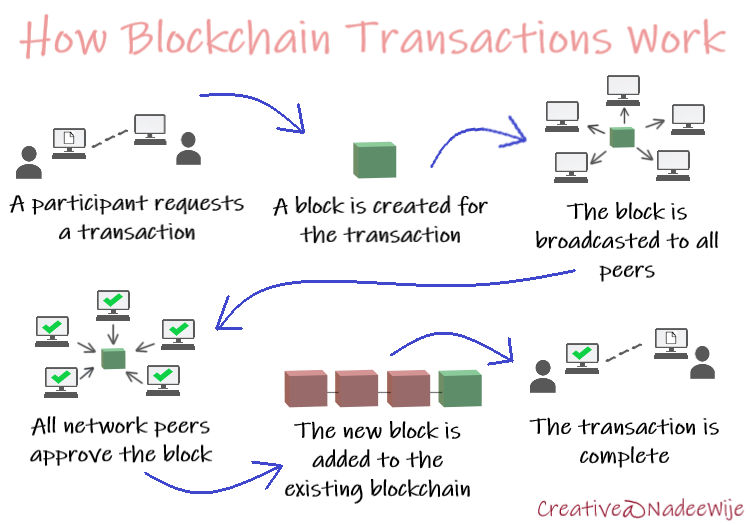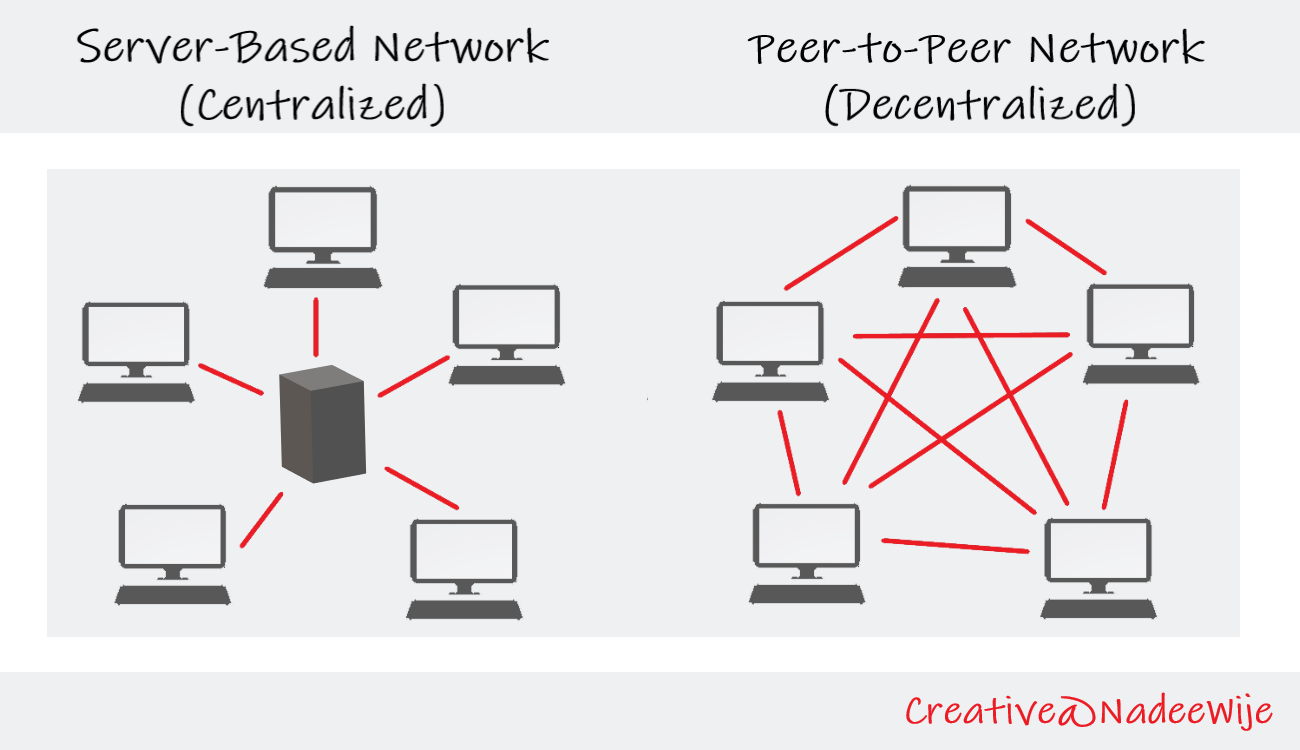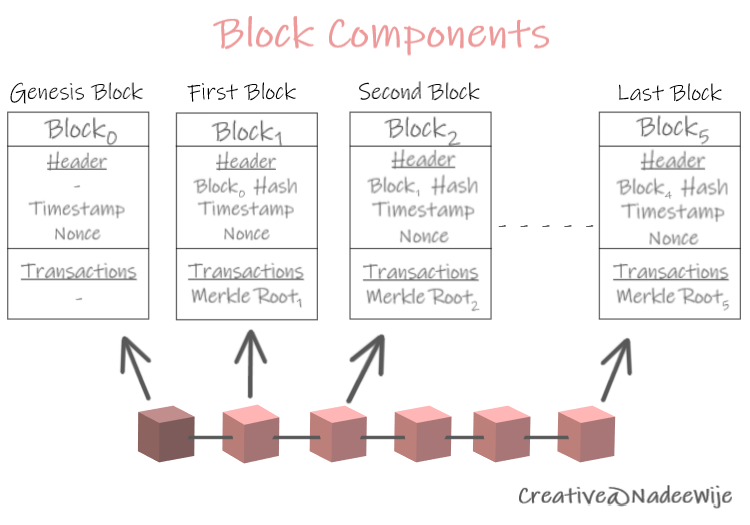Blockchain technology has disrupted banking, finance, logistics, and the list goes on. The technology has the potential to disrupt every industry, from healthcare to agriculture. It promises a secure and transparent future where no one can manipulate or control the system.
This post explores blockchain technology and explains the concept behind it.
What is Blockchain? How Does It Work?

Blockchain is a distributed digital ledger that records all transactions executed by all peers in a network. The chain consists of a sequence of blocks that stores a list of transactions.
Every transaction is verified by network peers using a consensus protocol before getting added to the blockchain. Once a transaction is recorded in a block, it is immutable.
Each block stores transaction data (encoded into a Merkle tree), a timestamp, and the cryptographic hash of the previous block. The hash links the blocks in the form of a chain using cryptography to ensure security.

A Brief History
The idea of cryptographically secure storage was first conceptualized by Stuart Haber and W. Scott Stornetta in 1991. They presented the concept in the journal article How To Time-stamp a Digital Document.
In the article, the authors tackled the problem of time-stamping digital data to prevent individuals from back-dating and forward-dating documents. They proposed a scheme for digital time-stamping using cryptographically secure collision-free hash functions.
The following year, Dave Bayer along with the original authors Haber and Scott introduced Merkle trees in Improving the Efficiency and Reliability of Digital Time-Stamping. This was done to improve the resource-intensive and time-consuming process of storing and verifying time-stamp certificates.
In 2008, an unknown person or group of people under the alias Satoshi Nakamoto further improved the design. They introduced the new design as “block chain” in the whitepaper Bitcoin: A Peer-to-Peer Electronic Cash System to serve as the public transaction ledger of bitcoin.
Nakamoto implemented blockchain in 2009, which serves as the public digital ledger for all bitcoin transactions.
During the past decade, blockchain gained substantial influence, becoming a disruptive force with the power to revolutionize every industry.
The Structure of Blockchain
Blockchains are managed by a distributed peer-to-peer (P2P) network. Each peer holds an identical copy of the digital ledger and time-stamping server.

Unlike the traditional database system, blockchain is not controlled by a single entity. All participants can have full access and control, cutting out the third party. However, no one can modify the blocks in the chain.
Peers can only read existing blocks, add new blocks, and maintain a copy depending on the permissions granted by the owner of the blockchain.
Inside A Block
Blocks store verified transactions hashed and encoded into a Merkle tree. They are linked via the cryptographic hash of the previous block, forming a chain of blocks.
A block typically stores the block version, Merkle tree root hash value, timestamp, nonce, the hash value of the previous block, transaction counter, and transaction data.

Types of Blockchain
There are four main types of blockchain.
Private
Private (or permissioned) blockchains have restricted access. An invite from the admin is required for access and a control layer governs the actions of permitted participants. RippleNet and Hyperledger are applications built with private blockchains.
Public
Unlike private blockchains, public blockchains have no access restrictions. Everyone can access the ledger and execute the consensus protocol without an invite. Bitcoin and Ethereum are applications built with public blockchains.
Hybrid
Hybrid blockchains combine the benefits of both private and public blockchain. The public section is made available to everyone. However, the private section is restricted, requiring an invite to gain access. XinFin is a hybrid blockchain application.
Sidechains
Sidechains branch out parallel to a parent blockchain. Entries of the parent chain can be linked to and from the sidechain, allowing them to operate independently.
Blockchain Applications
Although blockchain is best known for cryptocurrency, the applications go far beyond. These applications leverage the transparency and security of blockchain.
Cryptocurrency
Cryptocurrencies are digital assets used as a form of exchange in place of money. The ownership records are stored in a digital ledger secured by cryptography – blockchain. Blockchain acts as the transaction database for most cryptocurrencies including Bitcoin and Ether.
Finance
Blockchain has the potential to speed up banking processes, thus improving efficiency and cutting down costs. UBS and several other global financial service providers have dedicated labs for blockchain research.
Initial coin offerings (ICOs) and Security Token Offering (STOs) are some blockchain-based financial assets currently used.
Insurance
Through blockchain-enabled smart contracts, customers and insurers are able to manage claims securely and transparently. This eliminates invalid claims as all contracts recorded on the blockchain are verified and immutable.
Healthcare
Blockchain-based solutions are used to store medical history and general patient information while addressing privacy concerns. This medical health data can be further linked to data generated from connected medical devices for convenience.
Internet of Things
Coupled with sensors and smart chips, blockchain enables reliable location tracking of goods as they move through the supply chain. This ensures traceability, which in turn ensures supply chain efficiency, and product security whilst simplifying process optimization.
Blockchain Is The Future
Despite the technology’s drawbacks in terms of scalability and flexibility, blockchain has tremendous potential.
As stated by Don, an influential authority on innovation, in a blockchain thought leadership post:
Blockchain represents the second era of the internet. Twenty-three years ago we thought the internet was the most extravagant thing to ever hit our homes, allowing us a portal into the unknown.
Don Tapscott